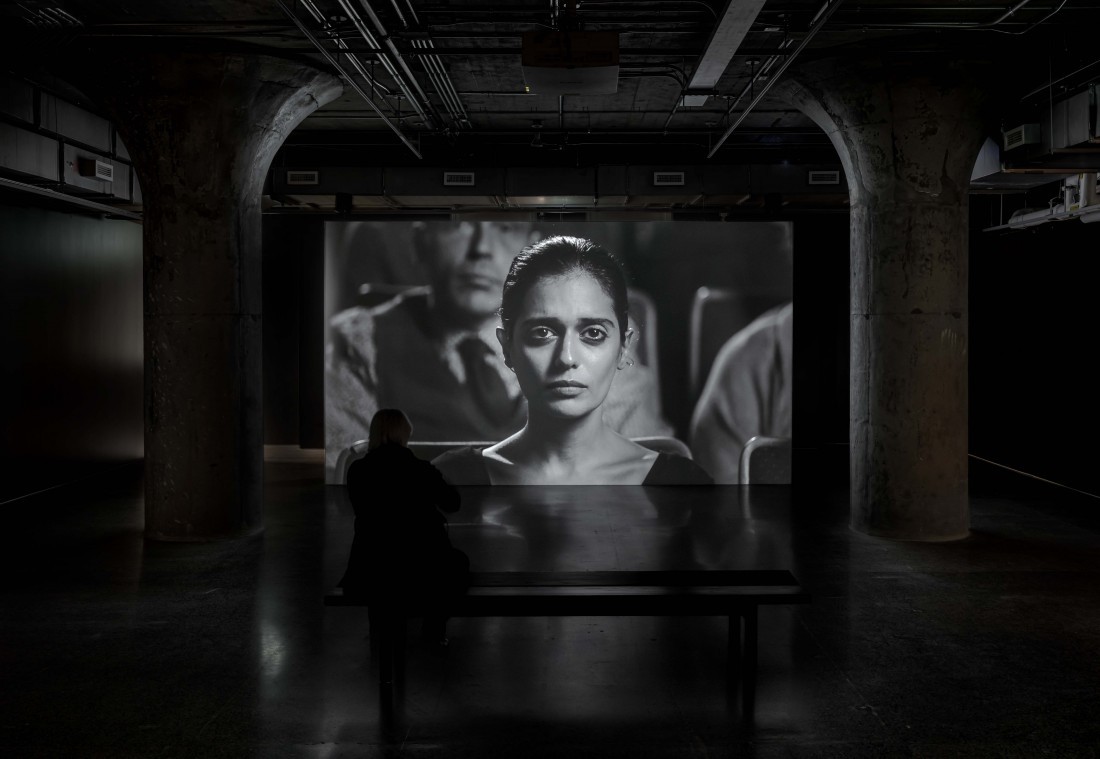Shirin Neshat
Spanning nearly 30 years, Shirin Neshat’s exhibition of film, video and photography, which includes only four discrete works, while broad, is not a retrospective. Although it has connective threads—notions of duality that range from cultural to gender polarities, a critique of patriarchy and portrait photography—when the exhibition moves abruptly ahead a span of years from the controversial Women of Allah, 1993–97, and the international-career-establishing Rapture, 1999, to the two most recent works, Roja, 2016, and the expansive video and photography installation Land of Dreams, 2019, the exhibition’s focal point, the gap remains unresolved.
Neshat produced the black and white photographic series Women of Allah following a return to postrevolutionary Iran after many years in exile. She depicted gun-toting women who were simultaneously veiled and powerful. Like Women of Allah, Rapture explores Middle Eastern gender dynamics. A Golden Lion winner at the Venice Biennale of that year, the two-channel black and white video installation, projected on opposite walls with viewers situated in the middle, considers male and female dualities. A group of men wearing white shirts pass through an ancient alleyway to a fortress overlooking water; a group of women wearing black chadors walk from desert to water. The installation addresses the opposing spaces that men and women stereotypically represent: chaotic nature for women and ordered culture via architecture for men.
Rapture and Women of Allah thus introduce the duality and portraiture still present in Neshat’s work. Still, there is no clear indication of how her earlier exploration of the changes in post-revolutionary Iran, the sexual politics of fundamentalism and the subsequent militancy of some women transition to newer, more abstract, surreal work exploring Iranian-American identity through dreams.
Roja, part of a trilogy of films titled Dreamers, explores metaphorically the displacement arising from Neshat’s experience as an Iranian living in the US in exile since 1996. Based on one of Neshat’s dreams, the black and white film depicts a bare-chested older man alone on a theatrical stage. He invites a woman sitting alone in the audience to come on stage, but she is hesitant. He becomes increasingly hostile, insulting her—calling her a “liar,” “deceiver” and “manipulator.” The audience transforms into a dreamy, light-bathed white, except her. She is singled out—alone. Her alienation from both the audience and the performer analogizes her living in a grey zone between two cultures.

Shirin Neshat, installation view, Land of Dreams, 2019, 111 photographs (not all shown in documentation), digital c-print with ink and acrylic paint, dimensions vary. Installation view 2022, MOCA Toronto. Photo: Toni Hafkenscheid. © Shirin Neshat. Courtesy the artist; Gladstone Gallery, New York/Brussels; and Goodman Gallery, Johannesburg, Cape Town/ London.

Shirin Neshat, Roja, 2016, single-channel black and white video/audio installation, duration 15 minutes and 20 seconds, edition of 6 + 1 AP. Installation view 2022, MOCA Toronto. Photo: Toni Hafkenscheid. © Shirin Neshat. Courtesy the artist; Gladstone Gallery, New York/Brussels; and Goodman Gallery, Johannesburg, Cape Town/ London.
Land of Dreams includes a two-channel black and white video installation, comprised of two films, titled Land of Dreams and The Colony, and 111 portrait photographs. Land of Dreams, shot in a bleak New Mexican landscape of boarded-up small-town streets and dusty desert roads, follows the protagonist, Simin, as she travels to strangers’ households, knocking on their doors, and, on the premise of being an art student completing a project, asking the occupants if she can photograph them and document their latest dreams. Sharing dreams, of course, can build a fast intimacy with strangers, especially in one scene when a woman the student just met is lying in bed, recounting her dreams as the student photographs her.
In The Colony, the same character as appeared in Land of Dreams is an Iranian spy, working within a clandestine desert mountain bunker, archiving and analyzing dreams. What appears to be an archive or a library reveals itself as a cataloguing system for people’s dreams (the photos on the file boxes are the exhibited portrait photographs), and surveillance quickly emerges as a sub-theme. As does patriarchy, when, for instance, Simin consults a gruff, bearded, elderly man about her dreams. He holds up a photo of the woman Simin photographed in bed in Land of Dreams with a paternalistic air of authority. “Is this you: the dreamer?” he asks. The suggestion: the artist and subject’s dreams merge. While different cultures share common dreams, authoritarianism can still determine the freedom dreams represent, in this case cataloguing, surveilling and interpreting them. Thus, the universality that dreams should ideally embody is debunked as subject to surveillance and politicization.
With their stark black backgrounds, their dense, salon-style hanging and neutral grey walls as backdrops, the portrait photographs form a sombre installation. They link to the two films, overlapping the films’ fictional narratives. Neshat shot the portraits in New Mexico and asked her subjects to share their recent dreams, but she found her actual subjects through an open call, not, as in the film, by travelling door to door. The images appear as conventional studio portrait photographs— except for text in Farsi and cryptic illustrations providing interpretations of the sitters’ last dreams based on an antiquarian Iranian book of dreams. As with much of her work, Neshat leaves ample space for the viewer’s interpretation, loosely proposing through portrait and untranslated text a link between subject and artist and Iran and America.
Shirin Neshat’s recent work may not have the stark, immediate impact of Rapture’s direct juxtaposition and Women of Allah’s radical militancy. However, it does form a nuanced play between dualities: cultural divisiveness, intimacy and distance, and individual freedom and surveillance. ❚
“Land of Dreams” was exhibited at the Museum of Contemporary Art Toronto, Toronto, from March 10, 2022, to July 31, 2022.
Earl Miller is an independent art writer residing in Toronto.

